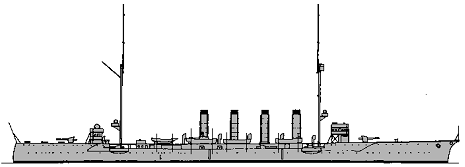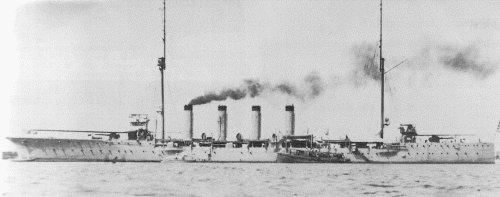

Chikuma 1915
| Name | No | Yard No | Builder | Laid down | Launched | Comp | Fate |
| 筑摩 [Chikuma] | Sasebo K K | 1.4.1909 | 1.4.1911 | 17.5.1912 | stricken 4.1931 | ||
| 平戸 [Hirado] | Kawasaki, Kobe | 10.8.1910 | 29.6.1911 | 17.7.1912 | stricken 4.1940 | ||
| 矢矧 [Yahagi] | Mitsubishi, Nagasaki | 20.6.1910 | 3.10.1911 | 27.7.1912 | hulk 4.1940 |
|
Displacement normal, t |
5000 |
|
Displacement full, t |
5040 |
|
Length, m |
144.8 oa 134.1 pp |
|
Breadth, m |
14.2 |
|
Draught, m |
5.10 |
|
No of shafts |
2 |
|
Machinery |
Chikuma, Hirado: 2 Kawasaki-Curtis steam turbines, 16 Kampon boilers Yahagi: 2 Mitsubishi-Parsons steam turbines, 16 Kampon boilers |
|
Power, h. p. |
22500 |
|
Max speed, kts |
26 |
|
Fuel, t |
coal 1128 + oil 300 |
| Endurance, nm(kts) | 10000(10) |
|
Armour, mm |
belt: 89 - 50, shields: 25, deck: 57 - 38, CT: 102 |
|
Armament |
6 x 1 - 152/45 41-shiki, 8 x 1 - 76/40 41-shiki, 2 x 1 - 6.5/115, 3 - 450 TT (1 bow, 2 beam) |
|
Complement |
414 |
Project history: First Japanese (and one of first-ever) modern light cruisers with an armored belt and turbines. They were built under 1907 Programme.
Ship protection: 89-50mm belt was connected by upper edge with flat 57-38mm deck. Guns had 25mm protection.
Modernizations: 1913, all: - 4 x 1 - 76/40; + 2 x 1 - 152/45 41-shiki
1924, all: - 3 - 450 TT; + 2 x 1 - 76/40 3-shiki, 2 x 2 - 533 TT; boilers were replaced by 6 Kampon
1932, Hirado: - 2 x 1 - 76/40
1932, Yahagi: - 1 x 1 - 76/40
Naval service: In 1914 Chikuma shared in chase for Spee squadron. After being stricken all three cruisers were used some time as hulks. Hirado and Yahagi were ultimately broken up in 1947, final fate of Chikuma is unknown.

Yahagi 1930s
© Ivan Gogin, 2008-14